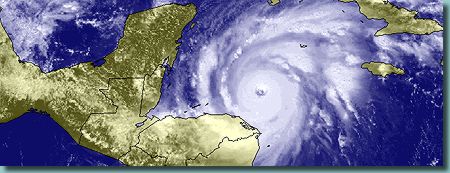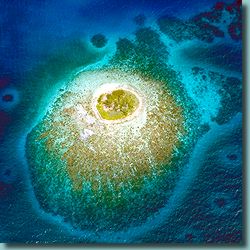


|
||||||||||
June to September are the wettest months in Belize, with a pronounced dry season between February and April. Rainfall varies from about 50 inches in the north to 160 in the south. At the Latitude of Laughing Bird Caye National Park, the average rainfall is approximately 95 inches per year. Minimum temperatures in Belize vary from 12° C (54° F) in January and December to a maximum of 38°C (100° F)in August. But mean temperatures range from 24° C (75° F) in winter to 27° C (80° F) in summer. The tidal range in Belize is only about 2 feet maximum, but local wind and swell conditions may affect that level by a foot or more. The main Caribbean currents outside the barrier reef are generally north to south, while water movement on the coastal shelf is mainly to the south into the Gulf of Honduras.  Hurricane Mitch - oct. 26, 1998 just before moving south and missing Belize by 200 miles Hurricanes occur in the Caribbean during the months of July to October. Historically, the Belize hurricane season is restricted to the last part of October. Especially destructive storms have been recorded in 1787, 1813, 1827, 1831, 1931, 1942, 1945, 1955, and 1961. The most recent storms t affect the Belize coastal zone have been Greta in 1978 and Mitch in 1998.
Eleven different types of islands (called "Cayes" in Belize) have been identified in the Belize coastal zone:
Laughing Bird Caye is the southernmost of the islands in the central lagoon region of the Belize coastal zone. It is perched on the eastern ridge of the Laughing Bird Faro, 14 miles from the coast and about 9 miles from the barrier reef. 
Laughing Bird Caye is classified as a sand and shingle cay. It is a relatively large and stable island. The island itself is an elongated sand ridge about 1400 feet long and between 20 and 120 feet wide. It has a shingle ridge on the windward side and sandy beach on the leeward edge. The center of the island is generally high without any depressions. The island is covered with coconut trees and scattered coastal mangroves. Seven plant species have been recorded on the island:
The Caye derives its name from the Laughing Gull which use to nest on the island and can still be seen there. Other birds can be seen on the Caye including the Brown Pelican, Green Heron, Melodious Blackbird and many other birds from the surrounding cayes and strays from the mainland. There are also a variety of lizards and insects on the Caye. |
||||||||||
 The Belize reef system lies in the zone of the Northeast Tradewinds, which blow with great consistency between April and September. The Trades are often interrupted between November and February by "northers", 4-5 day periods of heavy northerly winds.
The Belize reef system lies in the zone of the Northeast Tradewinds, which blow with great consistency between April and September. The Trades are often interrupted between November and February by "northers", 4-5 day periods of heavy northerly winds.
